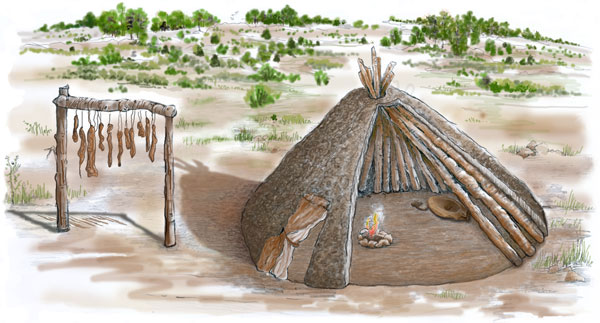Peoples of the Mesa Verde Region
Archaic: 6000 to 500 B.C.Housing

"Cutaway" view of an Archaic house, showing the fire hearth and details of wall construction. To the left of the house is a food-drying rack. Because Archaic peoples traveled throughout the year in search of food, their homes had to be very simple and easy to build. Few houses dating to this period have been found in the Mesa Verde region, and those that have been found are very poorly preserved. Some houses during the Archaic period were built in open areas; others were constructed in natural rock alcoves, which provided some protection from the elements. Most Archaic houses were very similar to Paleoindian houses. Poles were leaned tipi-style around a shallow round or oval basin and then covered with brush and daub. Sometimes rocks were incorporated in the walls and around the base of the structure. Hearths and storage pits are often found both inside and outside Archaic houses. Archaeologists have discovered the remains of one house located north and east of, but not far from, the Mesa Verde region that was built using a different method. Like other houses dating to the Archaic period, this structure was built over a shallow basin, but its upper walls and roof were of "cribbed," not pole, construction. In this method of construction, logs were stacked horizontally in a circle around the basin. Each tier of logs was placed in a smaller circle than the one below it, eventually creating a domed structure. The outside of the structure was covered with brush and then sealed with a layer of daub. Some archaeologists believe that the different styles of houses on the Colorado Plateau during the Archaic period are a reflection of different groups of people moving into the area over time, each bringing its own local traditions, including construction techniques. |
|
Acknowledgments | Illustration credits | To borrow, cite, or request permission | Please take our survey! Title page for Peoples of the Mesa Verde Region |
|
 DONATE TODAY
DONATE TODAY
